Patterns and description of instructions for knitting a cape knitting needles were inherited by the modern generation from the previous one. At all times, knitting lovers tried to diversify their wardrobe with new fashionable and practical things made by themselves.
If previously beautiful handmade things were available to the upper class of the population, then in the modern world any needlewoman can create a warm and original cape for herself or her daughter from the threads of the yarn she likes. It is believed that knitting came to Russia from Scandinavian countries.
Types of knitted capes
A knitted cape, the patterns and description of which can be found in fashion publications of the 21st century, is popularly called a cape, and is currently a fashionable accessory for modern women who like to combine warmth, comfort and exclusivity in their clothes. Historians who have studied the topic of the appearance of capes have come to the conclusion that their ancestor was a classic downy shawl.
The Orenburg shawl, knitted from goat down by Russian craftswomen, was considered the pinnacle of craftsmanship throughout the world.
The fabric was so warm that, if worn under clothing, it allowed one to walk in winter without a fur coat and not freeze.
To keep the scarves from coming undone and to keep them on the body, they were secured with pins. Historians are sure that this later transformed into a shawl with a clasp or ties.
Other experts call the cape "French chic" and claim that it came to the Russian expanses from France. The word "pelerine" is translated from a foreign language as "pilgrim" or "wanderer".
A classic knitted cape is a round, sleeveless piece of fabric that does not reach the waist and covers the arms up to the elbows, the back and chest. There are capes with a hood or wrap, and some craftsmen make slits for the arms in it to make it more functional.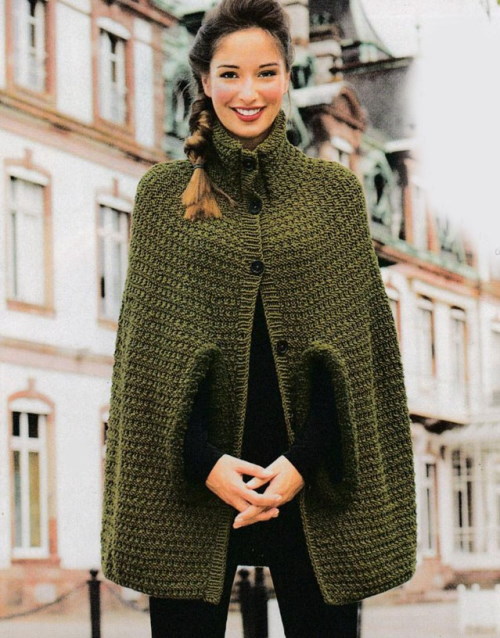
Capes were worn in the old days, both on outerwear and dresses and other things. There are several types of yarn capes.
These include:
- bolero;
- cape;
- bib;
- stole;
- poncho;
- shawl.
This type of cape, the bolero, came to the modern world from Spain, where it was the name of a part of the costume of a dancer performing a dance of the same name.
Usually it is a short jacket, not reaching the waist, with sleeves. Bolero can be with or without a fastener or ties. Also, some varieties of such a cape have no sleeves or a hood.
Every fashionista dreams of a long sleeveless coat, called a "Cape". The difference between it and a poncho is that the silhouette of the first fits beautifully on the figure and is not just a square or rectangular piece of fabric.
A bib is a knitted cape with a collar that covers the chest and shoulders. The classic dictionary defines this wardrobe item as a fabric insert that peeks out from under any clothing. The first bibs appeared on Russians who belonged to the nobility in the 18th century.
A stole is a rectangular shoulder cape made of velvet, yarn or fur. It can be worn by both sexes. The stole usually has no fastener.
Such a wardrobe detail as a poncho came to the expanses of Russia from Central and South America. It is a traditional national clothing of the indigenous Indians of these lands.
A shawl is also a type of cape and is a large square knitted scarf. The first shawls appeared in Kashmir in the 15th century and conquered all of Europe. It is known that Napoleon's wife had more than 300 shawls, which she not only wore, but also covered herself with during the cold season.
Yarn and knitting needles for the cape
Both cashmere and mohair are suitable for knitting a cape. In addition, the type of yarn depends on the effect you want to achieve when creating a thing. So, for example, if the model is light and summer, then take the corresponding thin threads. If the cape is knitted for the cold season, you and the yarn choose thick and warm.
The most popular yarns for creating capes are:
- "Alpaca";
- "Viscose";
- "Cashmere";
- "Mohair";
- "Cotton".
Skein "Alpaca" - these are threads created from the wool of cloven-hoofed animals with the same name. Such yarn is very warm, soft and gentle. In addition, products made from it are light, dirt-repellent and do not wrinkle.
Viscose is suitable for knitting demi-season and summer items. The yarn is created chemically and is made from cellulose. At the same time, it is considered the most natural of all threads that are not made from animal wool. Viscose products hold their shape well, are breathable and hygroscopic.
Cashmere yarn is made from the down of a certain type of goat that lives in the mountainous regions of China, Mongolia and India. The collection of raw materials for this type of thread is manual labor, and products made from 100% cashmere are highly valued in the market and are expensive. The qualities of the thread include its fine structure, softness, shine and warmth.
The yarn called "Mohair" consists of wool from Turkish goats living in the province of Angora. 100% thread from this material is very expensive, so such skeins are rare in pure form. The word "mohair" in translation from Turkish means "chosen hair" or "diamond fiber". Products made from it are durable, lightweight, warm, hypoallergenic and dirt-resistant. When worn and stored correctly, mohair items practically do not wear out.
Cotton thread is used to create light openwork items and lace. You can knit a decorative festive cape for a girl from it. This thread is made from cotton flowers. Among the unique qualities of the yarn, it is noted that its strength increases when wet, products made from it do not stick out and absorb moisture well.
Knitting needles are usually selected according to the thickness of the thread. The easiest way to determine the appropriate tool is to take a sheet of paper and pierce it with knitting needles of different diameters. After that, thread is pushed through the resulting hole and if it passes freely, without catching on the edges and, at the same time, without dangling, then the knitting tool is selected correctly.
Conventional symbols in knitting patterns
Cape with knitting needles, the schemes and description of which are easy to understand if you know the symbols and can decipher the pattern. The most common loops in knitting are front and back. The first are designated as "+", "X" or "I", and the second are depicted as a sign "-" or a half-arc with a back at the top.
Also found:
- "O" - yarn over;
- "V" - a slipped loop where the thread is behind the work;
- “Ɐ” is a slipped loop where the thread is left before work.
If there is any number above the "V", it indicates how many loops need to be knitted from one. Also, depending on the pattern, there are conventional symbols in the form of several straight lines supporting each other. Such a code should be understood as a recommendation for combining loops with a left or right tilt (depending on where the top line points).
In addition, there are abbreviations that tell you how to knit in a given row.
| Reduction | Transcript |
| lp | face loop |
| ip | purl stitch |
| kr. | edge |
| nak. | yarn over |
Experienced needlewomen recommend that those who have just begun to master the basics of knitting save a memo with symbols in a convenient place so as not to waste time deciphering them.
Step-by-step master classes on knitting women's capes
Patterns and descriptions of knitted capes can be selected for any taste. The appeal of knitted capes is that they not only decorate a woman, but can also hide figure flaws. The yarn product is combined with various things and accessories.
Models of women's capes are:
- openwork;
- everyday;
- on buttons;
- with sleeves;
- short;
- long;
- with a hood.
There are also many children's styles of capes that will suit girls and boys of any age. You can decorate capes for little and adult fashionistas with any decor: sequins, stones, beads, rivets.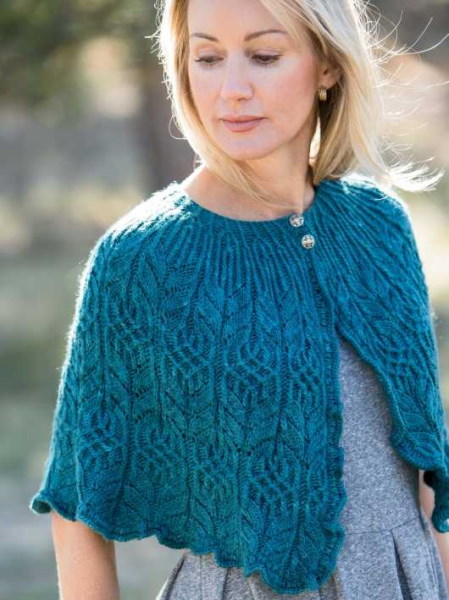
For the simplest model of a cape for an adult, you will need 0.1 kg of acrylic threads and 2 knitting needles.
To get a beautiful cape, you need:
- Cast on 71 stitches.
- Row No. 1 knit, alternating 1 front loop with 1 back loop.
- Row No. 2: knit all stitches purlwise.
- Alternate the pattern of rows 1 and 2, alternating them in turn over a distance of 120 cm.
- Close the loops of the last row in any convenient way.
- Sew the halves of the resulting fabric.
The product can be decorated with a wide ribbon of any color, sewn onto the cape. This way, you can hide the joining seam of the product, and rhinestones or beads sewn or glued to the ribbon will give the cape a festive look.
With hood and sleeves
A knitted cape, the patterns and description of which can be found with a hood and sleeves, even a novice needlewoman can easily make at home. Such a thing is suitable for a warm autumn or not hot spring. The hood will save you from the cool wind, and the sleeves will not let the cold penetrate to the body.
To knit a cape with sleeves and a hood, you will need 0.8 kg of yarn, consisting of polyacrylic and wool. You will also need 3 knitting needles and a button to match the color of the threads. The data is given for a standard women's size 42/46.
When creating the fabric, front and back loops are used, as well as the knitting patterns “Elastic”, “Large Pearl” and “Aran Knitting”.
To get the cape you need:
- Cast on 70 stitches to create the back.
- Knit row #1 with purl stitches only.
- Start with row #2 to knit the elastic, alternating 2 front with 2 back. There are edge loops at the beginning and end of each row. Knit 12 rows in this way.
- Starting from row #15, start creating a large pearl pattern. To do this, alternate the front and back stitches in the 1st row. In the back row, knit the stitches according to the pattern on the fabric.
- Continue knitting, alternating purl and knit. Repeat the pattern so that all odd rows are like the 15th, and all even rows copy the 16th.
- From row #17, begin adding loops and start with 2 loops, once at the beginning and at the end.
- In every second row after this, add 3 more loops 2 times.
- In the next even row, add 1 time 5 loops and another row 1 time 8.
- Knit all increases with large pearls.
- Start decreasing the stitches and in every 4th row remove 1 stitch at the beginning and at the end of knitting 9 times.
- At a height of 58 cm, close the remaining loops.
- Start creating the left side panel and cast on 48 stitches.
- Knit row #1 with purl stitches, taking into account the edge stitches.
- Start with row #2 to create the Aran pattern. To do this, after the edge loop, knit the front loop, 2 loops together using the draw method, and at the end of the row, combine the 3rd and 4th, after which comes the front loop and the edge loop again.
- Repeat patterns from rows 1 to 8 to obtain beveled stripes.
- Repeat the pattern from rows 1 to 6 to create flat braids, and for voluminous braids – from rows 1 to 10.
- Continue knitting the front and from the right edge of row No. 12 knit the strip, then add 1 loop.
- Knit the remaining part of the fabric with large pearls as described in the recommendations for the back.
- Move on to working on the neckline and for this, from 64 cm of fabric knitted with an Aran pattern, decrease 16 loops on the left side at a time.
- After this, in each even row, decrease 4 loops 1 time, 2 times 2, and 1 time 2.
- Close the remaining loops.
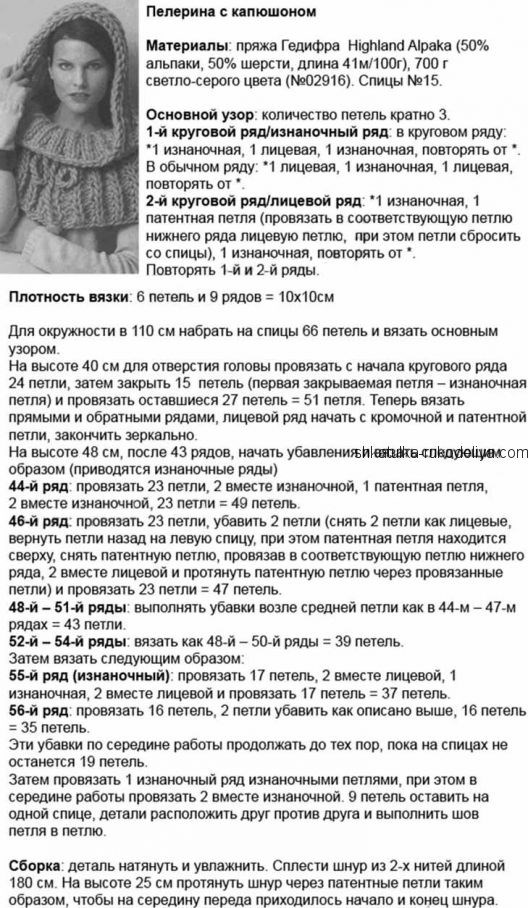
The right part of the cape is knitted in the same way as the left.
To create a hood you need:
- Cast on 95 stitches.
- Knit row #1 with purl stitches.
- Continue knitting the remaining rows with large pearls.
- Start decreasing the stitches in each even row when the fabric reaches 12 cm in length. To do this, in the 1st even row, remove 1 stitch 4 times, and in the 2nd even row, remove 2 stitches 2 times.
- Mark the middle at a height of 20 cm.
- Continue knitting 2 halves of the hood, each of which should have 39 loops, separately.
- Round off the fabric with shortened rows. To do this, in the 1st even row, remove 1 loop 4 times, and turn the work with a yarn over. In the next even row, remove 2 loops 1 time, then 3 and 4. After which, turn the work again, also with a yarn over.
- Knit the open loops of the halves in pairs and close.
The hood is put aside and we begin to create the sleeves.
To do this you need:
- Cast on 86 stitches.
- Knit row #1 as on the back.
- Knit 12 rows the same way as on the back.
- Distribute the loops for knitting large pearls and an Aran pattern, and for this remove the edge loop, knit 15 loops with pearls, 16 with an Aran loop (bevel on the left shelf), 22 with pearls, add 1 loop in the middle from the transverse thread, 16 with an Aran loop (bevel on the right shelf), 15 with pearls and 1 edge loop.
- In every 4th row, start decreasing 27 times by 1 loop, and in every 2nd row – 8 times.
- Close the work at a height of 58 cm.

At the final stage, the product is assembled. To do this, the sleeves are sewn along the seams and attached to the main fabric. The hood is also attached to the main fabric and a button is secured in the front, and a loop for it is made from threads.
Children's style
During the period when it is too early to put on a warm jacket, and it is already cold in a simple windbreaker, a poncho cape will come in handy for a child. The product can be knitted in any length.
For this style you will need 0.35 kg of wool yarn and circular knitting needles.
To knit a poncho for a girl, you need:
- Cast on 170 stitches.
- Knit 24 rows in garter stitch, alternating the front row with the back row.
- Starting from the 25th row, knit only front loops.
- From row 37, knit only purl stitches.
- Repeat the report 1 time.
- Continue knitting the fabric with the front surface.
- Perform a decrease in one of the rows, where after knitting 8 front loops from 2 loops, 1 front loop is formed. The pattern is repeated throughout the entire row.
- Knit the next row with knit stitches.
- Knit 12 cm in garter stitch.
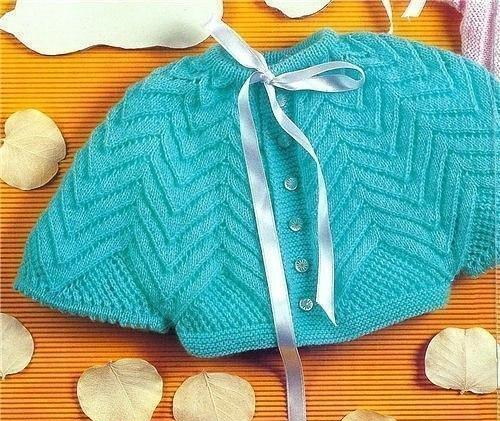
At the end of knitting, close the loops.
Elegant cape with clasp
A knitted cape, the patterns and description of which can be found with a clasp, is a fashionable thing for a woman of any age. Such a cape is worn both under formal trousers and under an evening dress.
To create a festive item, you will need 8 skeins of yarn, knitting needles and 3 buttons. You can choose yarn with lurex as a material for a festive cape.
To knit a cape yourself, you need:
- Cast on 88 stitches.
- Knit rows with a 2 x 2 elastic band, starting and ending with 3 front loops. Repeat the pattern until the fabric is 42 cm.
- Continue the fabric with shortened rows. To do this, after knitting 22 loops, turn the product, knit another 22 loops and turn again. Next, knit 44 loops, turn and again 44 loops.
- Knit 66 stitches and turn. Then knit 66 stitches again,
- Turn and knit 16 stitches, then 16 more and turn.
- Repeat the report with turns 13 more times.
- Turn and knit 44 stitches again, turn and repeat 44.
- Knit 66 stitches, then turn and knit the same number.
- Close the loops as soon as the fabric reaches a length of 42 cm.
The product is put aside and work begins on creating the belt loop.
To do this you need:
- Cast on 11 stitches.
- Knit 16 cm with the “Pearl Rib” pattern.
- Close the loops at the end.
They begin to assemble the cape. To do this, sew buttons to the belt loop at equal distances and attach it to the cape. After that, form the sleeve points and sew the cape.
Lace cape with buttons
A warm buttoned cape is the perfect solution for any weather. It will allow a girl to try herself in different looks and still feel comfortable.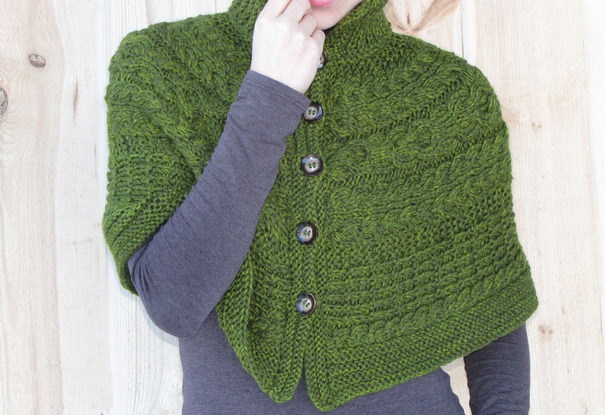
To create a 63 cm high and 70 cm girth item, you will need 0.6 kg of yarn, circular knitting needles and buttons of different diameters. In the knitting process, patterns such as "Purl Stitch", "4 by 4 Elastic" and "Garter Stitch" are used.
To knit a cape you need:
- Cast on 101 stitches.
- Knit the fabric with an elastic band.
- Form holes for buttons when the length of the fabric is 3 cm.
- On 7 cm of fabric make an edge, 4 loops of garter stitch, 92 - openwork pattern, 3 - garter, edge. To create openwork knitting you need to knit 4 front, 2 together front, 2 yarn overs, 2 together with tilts to the left, 4 front. So knit 304 rows.
- Form buttonholes along the right edge at 7 cm at the same time as you start creating the pattern.
- Knit 7 cm with a rib pattern and close the loops.
The cape is assembled by folding it in half and sewing on buttons.
The patterns and descriptions of the cape with knitting needles contain various patterns. Having learned how to knit a cape, the needlewoman will be able to diversify her wardrobe with various exclusive models.
Video about knitted cape
Cape master class:
